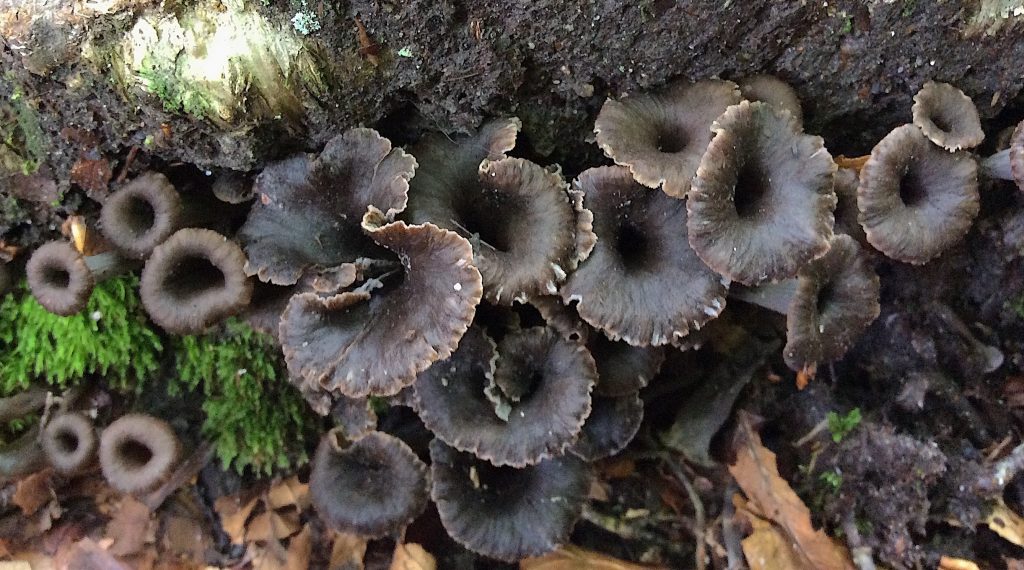
Edible Black Trumpet Mushrooms growing along a path. Photo by Green Deane
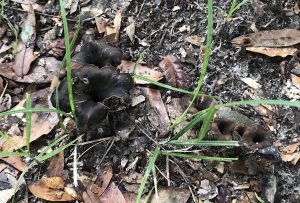
Black Trumpets found near St. Augustine. Photo by Green Deane
Black Trumpet Mushrooms (Craterellus fallax.) are among the easiest of mushrooms to identify but you have to look hard to find them. They camouflage well. Tasty, aromatic, it’s a species high on the foragers list. I know four places where they grow. Under Live Oaks at Princess Point. I have seen them also growing under hickories in Gainesville and along paths in Lake Mary Fl and Boone, North Carolina. This species throws a yellowish to orange spore print. It’s European relative, which it has been confounded with, has a white spore print. By the way “Craterellus” is a Latin form of “crater” and “fallax” means misleading, deceptive or false.
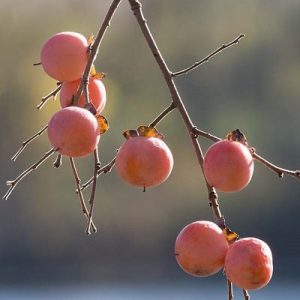
Ripe Persimmons in Winter Garden Florida. Photo by Green Deane
While I was out collecting edible mushrooms we also saw a persimmon tree with some ripe fruit… a couple of ripe fruit. They are mostly green this time of year but one has to ripen before the others. Persimmons are much maligned because they are astringent until extremely ripe. This one was on the sweet side and not astringent. From the tree’s perspective it does not want the fruit carried away by animals that can taste sweet until the seeds are ready to germinate. So the fruit stays non-palatable to most creatures until the last moment. The fruit seemingly turn sweet overnight. No frost is needed. The best persimmons are the ones you have to fight the ants for. Locally they usually ripen around October, give or take a week or two. Remember, the place to look for Persimmons trees are along edges…. edges of forests, edges of roads and rivers and paths. To read more about the Persimmon, which is North American’s only ebony, go here.

Classes are held rain or shine or cold. (Hurricanes are an exception.) Photo by Kelly Fagan.
More than a decade ago someone living in Cassadaga suggest I hold foraging classes at the park there and I have. That person, however, has never attended. Too bad, it’s a nice little park of varying terraine, plenty of wild edibles to see including mushrooms (this time of year.) And Sunday’s class in Largo at Eagle Lake, always a pleasant location with varying edibles.
Saturday August 29th, Colby-Alderman Park: 1099 Massachusetts Street, Cassadaga. FL. 32706. 9 a.m. to noon. Meet by the bathrooms.
Sunday August 30th, Eagle Park Lake, 1800 Keene Road, Largo, FL 33771. Meet at the pavilion near the dog park. 9 a.m. to noon.
Saturday September 5th, Red Bug Slough Preserve, 5200 Beneva Road, Sarasota, FL, 34233. 9 a.m. to noon.
Sunday September 6th, Wickham Park: 2500 Parkway Drive, Melbourne, FL. Meet at the “dog park” inside the park. 9 a.m to noon.
For more information, to pre-pay for a class, or to sign up go here.
Kudzu is known as the plant that smothered The South. It leaves the impression that if you fell asleep in a lawn chair at noon by supper time you would be covered by Kudzu. Driving or hiking through places like North Carolina one can see steep hillsides thickly blanked with the large, herbaceous vine. But it is the botanical beast it’s purported to be? We’ll see it in my foraging class Saturday in Cassadaga.
What important to us is that nearly the entire plant is edible: Leaves, growing tips, grape-scented blossoms, young roots and older root starch. Only the seeds are not edible by humans. However the plant does support wild life and domestically goats are particularly fond of it. Turning Kudzu into goat products is profitable, tasty and sustainable. While Kudzu can be a local problem its invasiveness has been exaggerated by regional writers.
Kudzu was first championed during the Dust Bowl Era in the 1930’s because it was the prime plant for fighting erosion. Folks were paid to sow it on their land (no complaining then.) About a million acres were planted in the next 20 years then the program ended. Kudzu meanwhile had worked its way into southern novels and folksy observations. It became a southern cliche. In reality Kudzu occupies about one tenth of one percent of the South’s 200 million acres of forest, or 227,000 acres. Asian Privet, which is rarely commented on by anyone, occupies some 3.2 million acres, 14 times that of Kudzu. The vine is spreading but at a thousandth-something rate of around 2,500 acres a year. And in time it might be significantly reduced: A few years ago a Japanese Kudzu bug was found in a garden in Atlanta (a city which is six times the size of the Kudzu infestation.) The bug was a stowaway on some plane. It is now successfully devouring Kudzu. In one test site it ate a third of the Kudzu in two years. In decades to come Kudzu might be but a bucolic memory, a quaint reference to how it used to be. To read more about Kudzu, go here.
September approaches and that means wild apples. I’ve never met a bad wild apple. There are sweet ones — edible off the tree — and there are bitter ones, often very good after roasting like a root vegetable. Nearly all apples are edible and are clones, well, at least commercial apples are clones. The experts tell us no two apple seeds are exactly alike. Granny Smith apple seeds will not product a Granny Smith apple. The first Granny Smith apple tree was a unique tree and was cloned, as were all the other named apples we buy in the store or grow at home. Cloning might not be exactly the right term: Cuttings were taken from that tree and grafted on to other apple trees. That’s why it took nearly a century for the Granny Smith apple to get from Australia to our markets in the United States.
What I noticed as a boy was the great variety of apple trees there were around the fields, old homesteads, and roads where I grew up. Near the house, where our horses could raid it, was an old small wild apple that had green fruit tasting tart to bitter. We made pipes out of the wood. But, the apples cooked well and the horses liked them as is, right off the tree with a few leaves. Just outside their fence there was a large (I suspect cultivated) tree with apples that tasted similar to a Golden Delicious. Across the dirt road from the house were five apple trees by the road, offspring of a tossed apple core and subsequent generations.
I thought of these while hiking the Appalachian Trail. Feral apple trees were common and good. I harvested apples every time I saw a tree. Not one tree looked as if anyone had bothered to collect any apples from them (low-hanging fruit was still low-hanging.) This latter observation is perhaps the most telling. Humans have been eating apples for some seven thousand years. They are one of the best known foods even among people who never forage. It is difficult to think of a food more recognizable than apples yet they remained unharvested along the trail and elsewhere. Even ardent must-get-back-to-nature types leave them alone. Maybe we are not as hungry as we think we are. I also see mangoes rotting on the ground often. To read more about apples, go here.
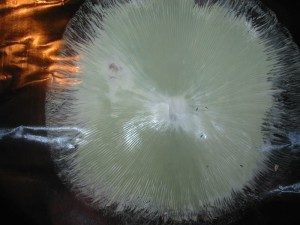
The False Parasol throws a green spore print. Photo by Green Deane
What is that mushroom on your lawn? Locally a toxic mushroom has been responding to the rain, the Green Spore Parasol also called the Green Parasol, Chlorophyllum molybdites. It causes more non-fatal mushroom poisonings than any other species in North America. This is because it has some close look alikes that are edible. The Green Spore Parasol is close to unique in that it is among the few mushrooms with green spores. If you pull off the stem and lay the cap on a white piece of paper or clear plastic for a few hours to a day it will leave a green spore print. A larage mushroom, they almost aways pop up on lawns and often in a “troop” or what we used to call a fairy ring. Also called the “Gut Wrencher” and the “Vomiter” a few people seem immune to its toxin but don’t try it. The one death on record involved a two-year old child who ate some raw, had convulsions, then died 17 hours later. Adults usually get go-to-the-hospital diarrhea, among other gastro-intestional symptoms. There is, however, no lasting organ damage. The mushroom is, however, is deadly to horses.

Green Deane videos are now available on a USB.
Changing foraging videos: My nine-DVD set of 135 videos has been selling for seven years and are still available. They are the same videos I have on You Tube. Some people like to have a separate copy. A second option is a16-gig USB that has those 135 videos plus 15 more. While the videos can be run from the DVDs the videos on the USB have to be copied to your computer to play. They are MP4 files. The150-video USB is $99 and the 135-video DVD set is now $99. The DVDs will be sold until they run out then will be exclusively replaced by the USB. This is a change I’ve been trying to make for several years. So if you have been wanting the 135-video DVD set order it now as the price is reduced and the supply limited. Or you can order the USB. My headache is getting my WordPress Order page changed to reflect these changes. We’ve been working on it for several weeks. However, if you want to order now either the USB or the DVD set make a $99 “donation” using the link at the bottom of this page or here. That order form provides me with your address, the amount — $99 — tells me it is not a donation and in the note say if you want the DVD set or the USB.

Green Deane Forum
Want to identify a plant? Perhaps you’re looking for a foraging reference? You might have a UFO, an Unidentified Flowering Object, you want identified. On the Green Deane Forum we — including Green Deane and others from around the world — chat about foraging all year. And it’s not just about warm-weather plants or just North American flora. Many nations share common weeds so there’s a lot to talk. There’s also more than weeds. The reference section has information for foraging around the world. There are also articles on food preservation, and forgotten skills from making bows to fermenting food.
This is weekly newsletter #420, If you want to subscribe to this free newsletter you can find the sign-up form in the menu at the top of the page.
To donate to the Green Deane Newsletter click here.

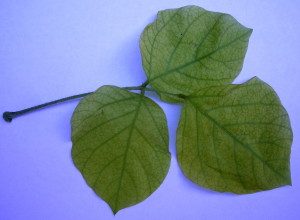
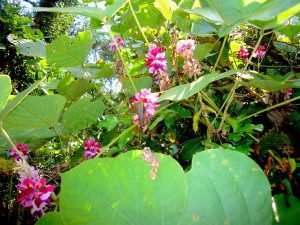
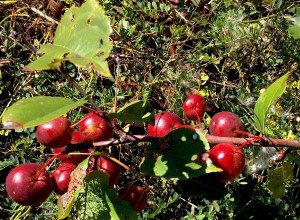
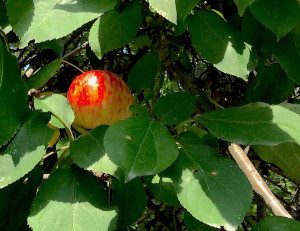

Thanks again for all you do in your weekly emails!
Keep up the GOoD work!
Dan